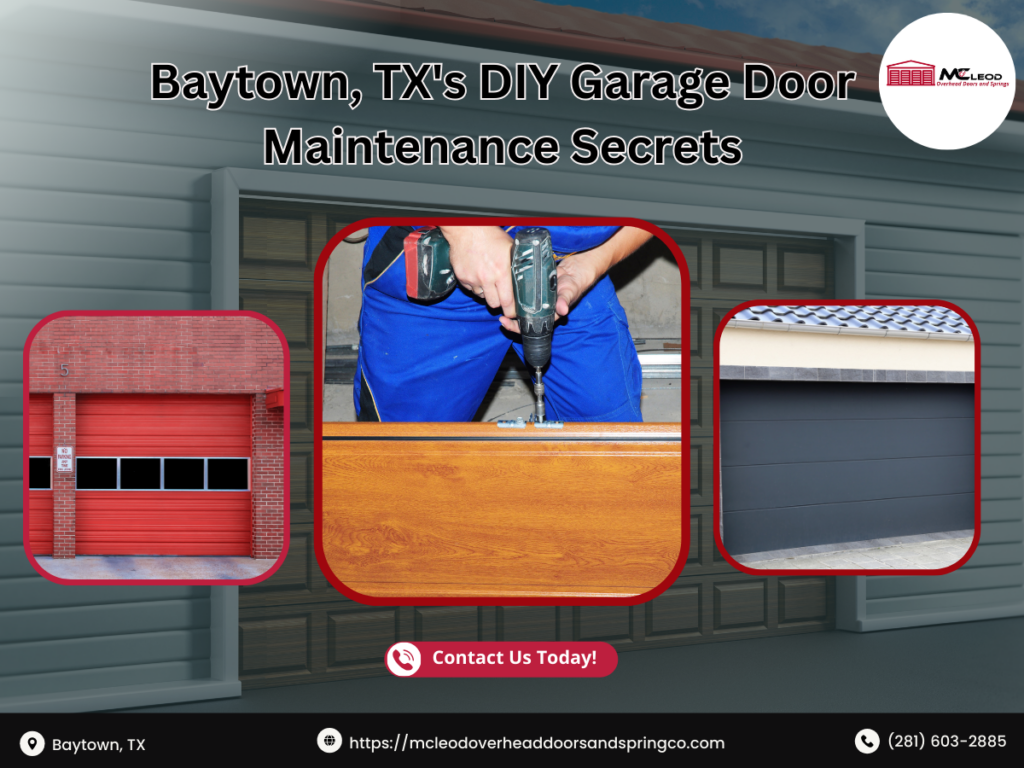Discover the secrets to DIY garage door maintenance in Baytown, TX, and learn how regular care can keep your garage door running smoothly. From understanding your garage door’s anatomy to troubleshooting common issues, McLeod Overhead Doors and Springs has you covered with expert advice and professional assistance.

Welcome to Baytown, TX‘s DIY Garage Door Maintenance Secrets. Are you ready to unlock the mysteries of garage door upkeep? Buckle up as we dive into the essential tips and tricks to keep your garage door in top-notch condition. Whether you’re a seasoned DIY enthusiast or a newbie looking to save some bucks, this guide is for you.
Maintaining your garage door isn’t just about aesthetics; it’s about functionality and safety too. A well-maintained garage door not only enhances the curb appeal of your home but also ensures smooth operation and prevents potential accidents. With regular maintenance, you can extend the lifespan of your garage door and save yourself from costly repairs down the road.
At McLeod Overhead Doors and Springs, we understand the importance of a properly maintained garage door. As Baytown’s premier garage door service provider, we’re dedicated to helping homeowners like you keep their garage doors in tip-top shape. With our expertise and commitment to customer satisfaction, you can trust us to deliver exceptional service every time.
Understanding Your Garage Door
Anatomy of a Garage Door
Your garage door may seem like a simple gadget, but it’s made up of several intricate components working together to provide smooth operation. From the tracks and rollers to the springs and panels, each part plays a crucial role in ensuring your garage door functions properly.
Components and Their Functions
To effectively maintain your garage door, it’s essential to understand the function of each component. For example, the springs are responsible for counterbalancing the weight of the door, while the hinges allow for smooth movement as the door opens and closes. By familiarizing yourself with these components, you’ll be better equipped to identify and address any issues that may arise.
Common Types of Garage Doors
Garage doors come in various styles and designs, each with its own set of advantages and considerations. Whether you have a sectional, roll-up, or swing-out door, knowing the type of door you have is the first step toward effective maintenance. Each type may require different maintenance techniques, so it’s essential to understand the specifics of your door.
Essential Tools and Supplies
Must-Have Tools for DIY Garage Door Maintenance
Before diving into garage door maintenance, it’s crucial to have the right tools for the job. From wrenches and screwdrivers to lubricants and safety gear, having a well-equipped toolbox will make the job much easier and safer.
Wrenches, Lubricants, Safety Gear, etc.
When it comes to garage door maintenance, a few essential tools can go a long way. A sturdy wrench will help you tighten loose hardware, while a quality lubricant will keep moving parts operating smoothly. Additionally, don’t forget to prioritize safety by wearing protective gear such as gloves and safety glasses.
Recommended Supplies for Effective Maintenance
In addition to tools, having the right supplies on hand is equally important for effective maintenance. Cleaning solutions can help remove dirt and debris from the door surface, while weatherstripping can help prevent drafts and improve energy efficiency. Be sure to stock up on replacement parts as well, so you’re prepared for any unexpected repairs.
Routine Maintenance Tasks
- Checking and Tightening Hardware
One of the most crucial maintenance tasks is checking and tightening the hardware on your garage door. Over time, vibrations from regular use can cause nuts and bolts to loosen, leading to potential safety hazards. By periodically inspecting and tightening the hardware, you can ensure that your garage door remains secure and stable.
- Hinges, Rollers, Springs, etc.
Pay close attention to hinges, rollers, and springs, as these components are prone to wear and tear. Look for any signs of damage or corrosion, and replace any worn-out parts as needed. Additionally, make sure to lubricate these components regularly to keep them operating smoothly.
- Lubricating Moving Parts
Proper lubrication is essential for maintaining the smooth operation of your garage door. Be sure to lubricate the tracks, rollers, and springs regularly to reduce friction and prevent premature wear. Use a high-quality lubricant recommended by the manufacturer for best results.
- Tracks, Rollers, Springs, etc.
When lubricating the tracks, apply a small amount of lubricant along the entire length of the track, being careful not to overdo it. For rollers and springs, apply lubricant directly to the moving parts, making sure to wipe away any excess to prevent buildup.
- Cleaning and Inspecting Door Surface
Regular cleaning and inspection of the door surface are essential for maintaining its appearance and durability. Use a mild detergent and water to remove dirt and grime from the surface, and inspect for any signs of damage or wear.
- Removing Debris, Checking for Damage, etc.
Pay special attention to the bottom of the door, where debris can accumulate and cause damage over time. Remove any debris or obstructions from the tracks and make sure the door seals properly when closed. Additionally, check for any dents or dings in the door panels and repair them as needed.
Troubleshooting Common Issues
Identifying Noises and Their Causes
Is your garage door making strange noises? Don’t ignore them! Squeaking, grinding, or rattling noises could indicate underlying issues that need to be addressed. Take the time to identify the source of the noise and take appropriate action to prevent further damage.
Squeaking, Grinding, Rattling, etc.
Squeaking noises may indicate that hinges or rollers need lubrication while grinding noises could signal a more serious problem with the motor or gears. Rattling noises may be caused by loose hardware or worn-out components. Whatever the case, it’s essential to address these issues promptly to prevent further damage.
Addressing Balance and Alignment Problems
Is your garage door struggling to open or close smoothly? Balance and alignment issues could be to blame. Perform a balance test by disconnecting the opener and manually opening the door halfway. If the door doesn’t stay in place, it may be out of balance and require adjustment.
Testing Balance, Adjusting Spring Tension, etc.
Adjusting the garage door springs’ tension can help restore the door’s balance and improve its operation. However, adjusting garage door springs can be dangerous and should be done by a trained professional. If you suspect a problem with your door’s balance or alignment, don’t hesitate to call in the experts for assistance.
Dealing with Weather-related Wear and Tear
Rust Prevention, Weatherstripping Replacement, etc.
Harsh weather conditions can take a toll on your garage door, leading to rust and deterioration over time. To prevent weather-related wear and tear, consider applying a rust-resistant coating to metal components and replacing worn weatherstripping around the door frame. Additionally, make sure to keep the area around your garage door clear of debris and vegetation to prevent moisture buildup.
Safety Measures and Precautions
Importance of Safety in DIY Garage Door Maintenance
While DIY garage door maintenance can save you time and money, it’s essential to prioritize safety at all times. Garage doors are heavy and operate under tension, so it’s crucial to take proper precautions to avoid accidents and injuries.
Safety Tips for Handling Heavy Components
When working on your garage door, always wear protective gear such as gloves and safety glasses to protect yourself from injury. Additionally, be cautious when handling heavy components such as springs and panels, as they can cause serious injury if mishandled.
Springs, Panels, Cables, etc.
Garage door springs are under high tension and can be dangerous to work with. If you’re unsure how to safely handle or adjust garage door springs, leave it to the professionals. Likewise, be careful when working with garage door panels and cables, as they can cause injury if not handled properly.
Recognizing When to Call a Professional
While DIY garage door maintenance can help keep your door in good condition, some issues are best left to the professionals. If you encounter any problems that you’re not comfortable addressing yourself, don’t hesitate to call in the experts for assistance. At McLeod Overhead Doors and Springs, our team of experienced technicians is here to help with all your garage door repair and maintenance needs.
Whether you’re dealing with a malfunctioning opener, a broken spring, or a door that’s off its tracks, our experts have the knowledge and expertise to diagnose and repair the issue quickly and efficiently. We specialize in garage door installation, residential garage door repair and commercial garage door repair, or even emergency garage door repair, so you can trust us to handle any problem, big or small.
Don’t let garage door issues disrupt your daily routine or compromise the safety and security of your home or business. When in doubt, reach out to the professionals at McLeod Overhead Doors and Springs for the fast, reliable service you can count on.
Conclusion
Congratulations! You’ve taken the first step towards becoming a DIY garage door maintenance pro. By following the tips and techniques outlined in this guide, you can keep your garage door running smoothly for years to come. Remember, regular maintenance is key to preventing costly repairs and ensuring the safety and functionality of your garage door. And if you ever need assistance, you can trust McLeod Overhead Doors and Springs to provide expert service and support. Happy maintaining!
Follow us on our Socials:
